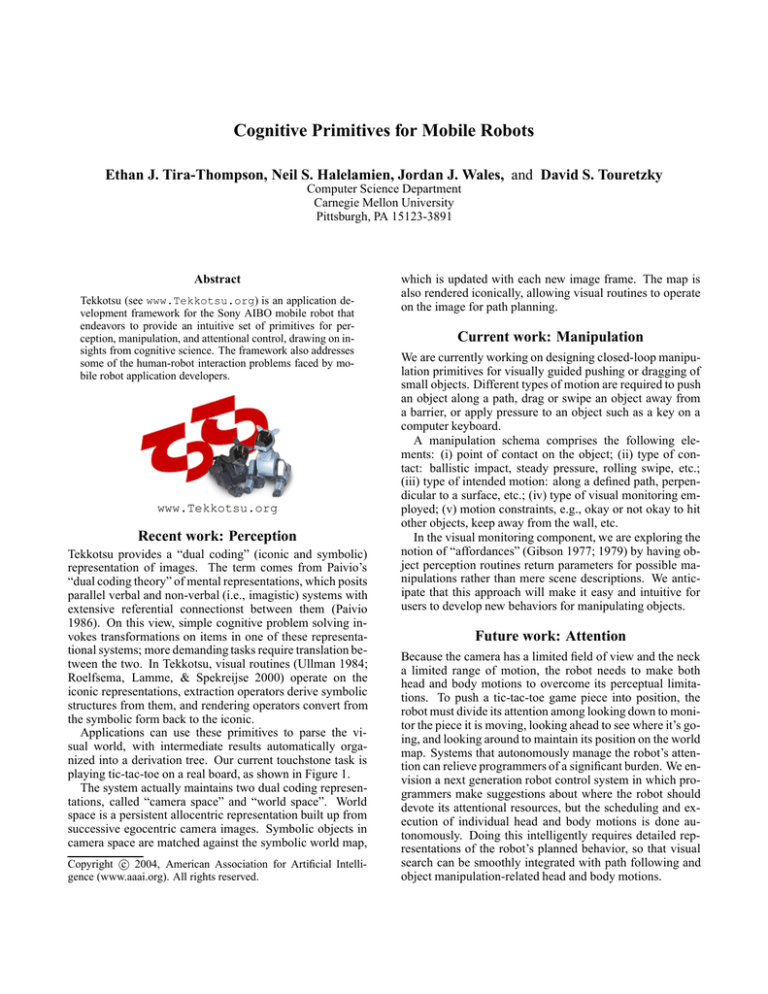
Cognitive Primitives for Mobile Robots
Ethan J. Tira-Thompson, Neil S. Halelamien, Jordan J. Wales, and David S. Touretzky
Computer Science Department
Carnegie Mellon University
Pittsburgh, PA 15123-3891
Abstract
Tekkotsu (see www.Tekkotsu.org) is an application development framework for the Sony AIBO mobile robot that
endeavors to provide an intuitive set of primitives for perception, manipulation, and attentional control, drawing on insights from cognitive science. The framework also addresses
some of the human-robot interaction problems faced by mobile robot application developers.
www.Tekkotsu.org
Recent work: Perception
Tekkotsu provides a “dual coding” (iconic and symbolic)
representation of images. The term comes from Paivio’s
“dual coding theory” of mental representations, which posits
parallel verbal and non-verbal (i.e., imagistic) systems with
extensive referential connectionst between them (Paivio
1986). On this view, simple cognitive problem solving invokes transformations on items in one of these representational systems; more demanding tasks require translation between the two. In Tekkotsu, visual routines (Ullman 1984;
Roelfsema, Lamme, & Spekreijse 2000) operate on the
iconic representations, extraction operators derive symbolic
structures from them, and rendering operators convert from
the symbolic form back to the iconic.
Applications can use these primitives to parse the visual world, with intermediate results automatically organized into a derivation tree. Our current touchstone task is
playing tic-tac-toe on a real board, as shown in Figure 1.
The system actually maintains two dual coding representations, called “camera space” and “world space”. World
space is a persistent allocentric representation built up from
successive egocentric camera images. Symbolic objects in
camera space are matched against the symbolic world map,
c 2004, American Association for Artificial IntelliCopyright gence (www.aaai.org). All rights reserved.
which is updated with each new image frame. The map is
also rendered iconically, allowing visual routines to operate
on the image for path planning.
Current work: Manipulation
We are currently working on designing closed-loop manipulation primitives for visually guided pushing or dragging of
small objects. Different types of motion are required to push
an object along a path, drag or swipe an object away from
a barrier, or apply pressure to an object such as a key on a
computer keyboard.
A manipulation schema comprises the following elements: (i) point of contact on the object; (ii) type of contact: ballistic impact, steady pressure, rolling swipe, etc.;
(iii) type of intended motion: along a defined path, perpendicular to a surface, etc.; (iv) type of visual monitoring employed; (v) motion constraints, e.g., okay or not okay to hit
other objects, keep away from the wall, etc.
In the visual monitoring component, we are exploring the
notion of “affordances” (Gibson 1977; 1979) by having object perception routines return parameters for possible manipulations rather than mere scene descriptions. We anticipate that this approach will make it easy and intuitive for
users to develop new behaviors for manipulating objects.
Future work: Attention
Because the camera has a limited field of view and the neck
a limited range of motion, the robot needs to make both
head and body motions to overcome its perceptual limitations. To push a tic-tac-toe game piece into position, the
robot must divide its attention among looking down to monitor the piece it is moving, looking ahead to see where it’s going, and looking around to maintain its position on the world
map. Systems that autonomously manage the robot’s attention can relieve programmers of a significant burden. We envision a next generation robot control system in which programmers make suggestions about where the robot should
devote its attentional resources, but the scheduling and execution of individual head and body motions is done autonomously. Doing this intelligently requires detailed representations of the robot’s planned behavior, so that visual
search can be smoothly integrated with path following and
object manipulation-related head and body motions.
Figure 1: (a) AIBO observing tic-tac-toe board. (b) View through the AIBO’s camera. (c) Parsed board image, with the robot’s
intended move highlighted.
Human-Robot Interaction
Tekkotsu has been used to explore several issues in humanrobot interaction. For some purposes it’s better to control
a robot remotely via a GUI tool or a command line interface, but other situations call for hands-on control, using
buttons on the robot’s body. Tekkotsu provides a menu system abstraction that supports all three modes of interaction.
Buttons on the body can be used to navigate a recursive
menu system, with feedback provided by audio cues and the
AIBO’s LED display. In the future we may add support for
a handheld PDA interface as well.
Tekkotsu’s philosophy is that robot operations should be
fully transparent. “Sketches” computed by visual routines,
and symbolic objects extracted from these sketches, are automatically organized into a derivation tree that is displayed
using a graphical browser (Figure 2), allowing the programmer to directly examine the robot’s parse of the image (Figure 3.) In addition, the robot can construct “sketches” specifically for display to the user, as in Figure 1(c) where it indicates its intended move.
Tekkotsu is in use at a dozen laboratories around the
world. Future plans include development of an undergraduate course in Cognitive Robotics to explore how people
can make use of cognitive primitives to more efficiently
construct new robot applications.
Figure 2: Graphical browser showing the derivation tree for
the tic-tac-toe board parse.
Acknowledgments: Supported by NSF REU supplement to
IIS-9978403, and a grant from the Sony corporation.
References
Gibson, J. J. 1977. The theory of affordances. In Shaw,
R. E., and Bransford, J., eds., Perceiving, Acting, and
Knowing. Hillsdale, NJ: Lawrence Erlbaum Associates.
Gibson, J. J. 1979. The Ecological Approach to Visual
Perception. Boston: Houghton Mifflin.
Paivio, A. 1986. Mental Representations: A Dual-Coding
Approach. New York: Oxford University Press.
Roelfsema, P. R.; Lamme, V. A. F.; and Spekreijse, H.
2000. The implementation of visual routines. Vision Research 40:1385–1411.
Ullman, S. 1984. Visual routines. Cognition 18:97–159.
Figure 3: Board pixels and extracted lines as displayed by
the graphical browser.




